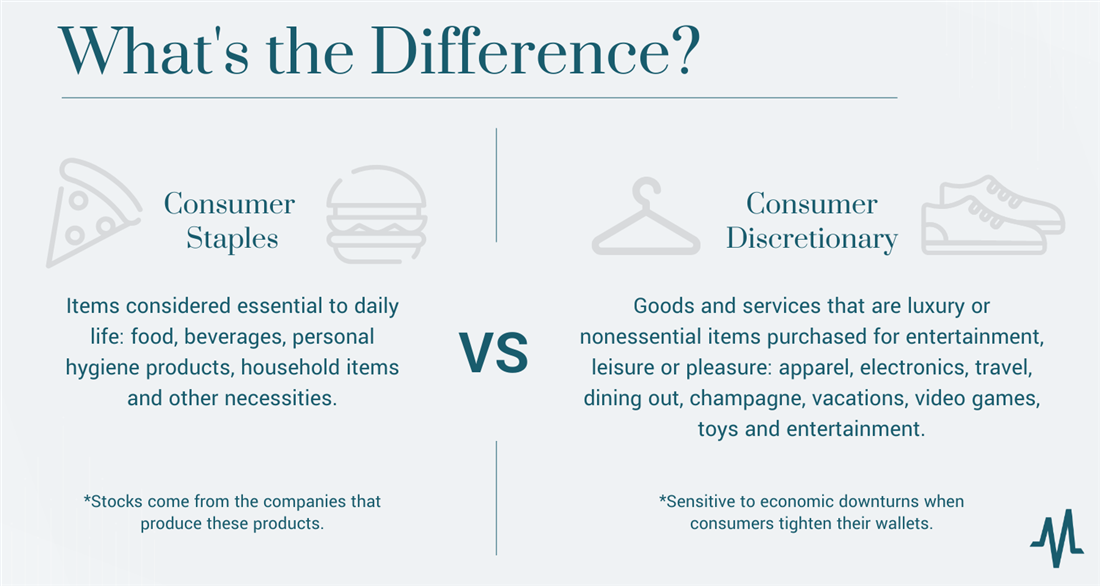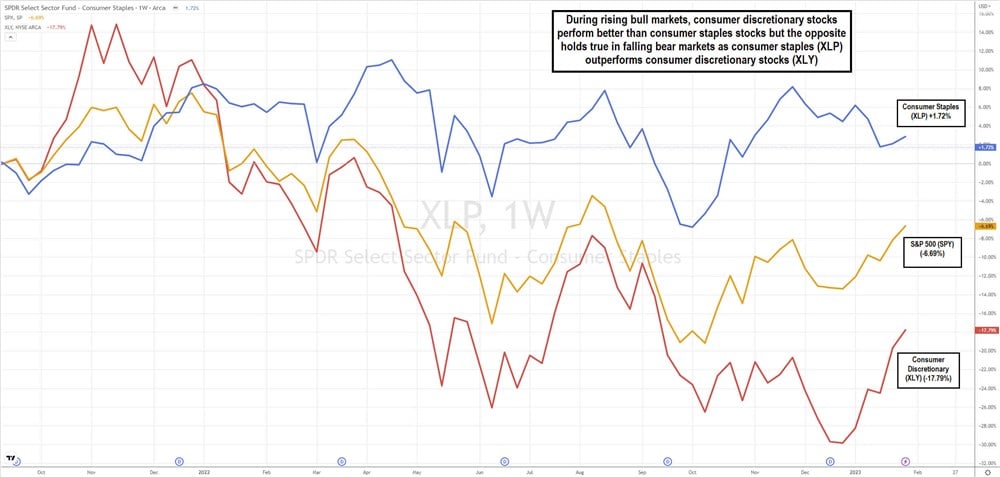Consumer staples and consumer discretionary have one thing in common: they affect consumers. In falling stock markets and weak economic climates, the term "consumer staples" became more familiar in the media. In rising bull markets and expanding economic climates, "consumer discretionary" tends to get thrown around more often.
When you hear the phrase consumer staples vs consumer discretionary, what does it mean? What does it mean when investors have to decide between consumer discretionary vs consumer staples stocks in their investment portfolios?
By the end of this article, you will be able to ascertain the differences between the two and how they react in different market conditions.
What Are Consumer Staples?
Consumer staples are items considered essential to daily life and purchased regularly. If your money was gone, what goods do you need to survive?
You'd need food, beverages, personal hygiene products, household items and other necessities.
Consumer staples stocks come from the companies that produce these products. They are considered conservative investments stable in weak economic climates since people still need these items most to go about their daily lives.

Examples of Companies that Produce Consumer Staples Products
Consumer staples companies are widely known household names that consumers are aware of as they commonly shop for those items. The Proctor & Gamble Company (NYSE: PG) is one of the most prominent consumer staples manufacturing consumer brands, which manufactures goods for beauty, grooming, healthcare, baby and feminine care products. The company produces shampoos, diapers, shaving products, toothpaste and household items like laundry detergents and dishwashing liquids.
Another well-known consumer staples company is Campbell Soup Co. (NYSE: CPQ) which produces nonperishable food items, including soups, snacks and beverages. Kellogg Co. (NYSE: K) manufactures ready-to-eat cereals and convenience foods like cookies, crackers and chips. Consumer staples stocks also include wholesalers and stores where consumers purchase such items. The Kroger Co. (NYSE: KR) operates grocery stores where consumers shop to buy consumer staple items. Costco Wholesale Co. (NASDAQ: COST) is one of the largest warehouse club stores in the world where consumers can purchase consumer staples items in bulk.
What is Consumer Discretionary Spending?
Consumer discretionary refers to goods and services that are luxury or nonessential items purchased for entertainment, leisure or pleasure. These are the things people buy when they have extra discretionary income to splurge on themselves or with friends, including optional items like consumer staples, such as apparel, electronics, travel, dining out, champagne, vacations, video games, toys and entertainment.
Consumer discretionary is more sensitive to economic downturns as consumers can quickly tighten their wallets during periods of high inflation, unemployment and economic uncertainty.
Examples of Companies that Produce Consumer Discretionary Products
Consumer discretionary stocks are companies that produce and distribute discretionary goods. High-end apparel manufacturers like Ralph Lauren Co. (NYSE: RL) and PVH Corp.(NYSE: PVH), makers of Cavin Klein and Tommy Hilfiger clothing, are well-known consumer discretionary brands. Live Nation Entertainment Inc. (NYSE: LYV) is one of the world's most extensive entertainment companies, operating live music concerts, sporting events, and promotions. Tesla Inc. (NASDAQ: TSLA) is the luxury electric vehicle (EV) manufacturer that has taken the world by storm, leading to EV adoption trends.
Differences Between Consumer Staples and Consumer Discretionary
There are stark differences between consumer staples and consumer discretionary stocks. These differences also determine the kind of investment you may wish to engage with your portfolio, depending on the macroeconomic climate.
Level of Necessity
Consumer staples have a higher level of necessity than consumer discretionary items. People need food, toilet paper, soap and toothpaste more than a designer handbag, video game system or a ticket to a Taylor Swift concert. During tough economic times, consumers have few choices between buying things they need over something they may want. Buying food takes priority over buying video games. In total economic boom times, consumers have the disposable income to purchase nonessential or luxury items for pleasure and entertainment.
Risk On or Off
Regarding consumer discretionary versus staples stocks, it boils down to the investor sentiment of putting risk on or taking risk off the table. Discretionary stocks are risk-on, as they are more aggressive and considered an offensive play during boom times when consumers spend for enjoyment. Staples stocks are considered risk-off, as they are more conservative investments tailored to economic downturns where consumers have tightened their wallets to only purchase the necessities during uncertain times.
Price Multiples
Consumer discretionary stocks tend to be more aggressive and carry higher price multiples since growth is an element of its pricing. Expect to pay higher prices for higher valuations for these stocks, especially technology stocks. During economic growth periods and bull markets, consumer discretionary stocks tend at higher multiples as they gain momentum on top-line growth. High inflation also tends to inflate asset values, further driving discretionary stocks higher in the near term.
The consumer price index measures the rate of inflation. A rising CPI equates to high inflation triggering interest rate hikes which cause discretionary stocks to fall as investors look for risk-off investments in consumer staples stocks to protect their capital. However, all good things end when interest rates get too high. The U.S. Federal Reserve will decrease inflation by raising interest rates. This is how the consumer price index affects stock market action.
Dividends
Consumer staples stocks tend to offer stable and consistent dividend payments, which adds an income stream benefit when owning these stocks. Dividends help to buffer against stock price volatility during economic downturns. While some consumer discretionary stocks also pay dividends, they usually reinvest the money into the company to prioritize growth through more spending. Dividend Aristocrat stocks tend to be consumer staples stocks representing stability throughout bull and bear markets.
Investment Considerations
When managing your portfolio and adjusting allocations based on economic climates, the rule of thumb is to consider having more allocation in consumer discretionary during bull markets and solid economic expansion periods with low-interest rates. These stocks have the most upside momentum and are more exciting as they tend to be on the cutting edge of innovations.
However, during bear markets and economic downturns, it's crucial to adjust your allocations to a risk-off stance and consider more investment in consumer staples stocks. These "boring," conservative investments will continue to generate steady profits and pay dividends while the risk-on discretionary stocks fall off a cliff.
Bull and Bear Market Performance
Stock market performance is a real-life measurement of consumer discretionary ETFs' performance against consumer staples ETFs. Investors can measure, track and invest directly in consumer staples and discretionary stocks through exchange-traded funds (ETFs). The S&P 500 Index (NYSEARCA: SPY) is the benchmark index. The Consumer Staples Select Sector SPDR Fund (NYSEARCA: XLP) is a liquid ETF to track the performance of consumer staples stocks. The Consumer Discretionary Select SPDR Fund (NYSEARCA: XLY) can be used to track and trade consumer discretionary stocks.
The charts tell the whole story of how they fare in an economic downturn. A historical line chart shows the actual performance of the XLP consumer staples ETF versus the XLF consumer discretionary ETF and their relation to the S&P 500.
Consumer Staples vs. Consumer Discretionary
Consumer staples vs consumer discretionary have one thing in common: they affect consumers. In falling stock markets and weak economic climates, the term consumer staples become more familiar in the media. In rising bull markets and expanding economic climates, consumer discretionary tends to get thrown around more often.
When you hear the phrase consumer staples vs consumer discretionary, what does it mean? What does it mean when investors have to decide between consumer discretionary vs. consumer staples stocks in their investment portfolios?
By the end of this article, you will be able to ascertain the differences between the two and how they react in different market conditions.
What Are Consumer Staples?
Consumer staples are items considered essential to daily life and purchased regularly. If your money was gone, what goods do you need to survive?
You'd need food, beverages, personal hygiene products, household items and other necessities.
Consumer staples stocks are the companies that produce these products. They are considered conservative investments stable in weak economic climates since people still need these items most to go about their daily lives.
Examples of Companies that Produce Consumer Staples Products
Consumer staples companies are widely known household names that consumers are aware of as they commonly shop for those items. The Proctor & Gamble Company (NYSE: PG) is one of the most prominent consumer staples manufacturing consumer brands, which manufactures goods for beauty, grooming, healthcare, baby and feminine care products. The company produces shampoos, diapers, shaving products, toothpaste and household items like laundry detergents and dishwashing liquids.
Another well-known consumer staples company is Campbell Soup Co. (NYSE: CPQ) which produces nonperishable food items, including soups, snacks and beverages. Kellogg Co. (NYSE: K) manufactures ready-to-eat cereals and convenience foods like cookies, crackers and chips. Consumer staples stocks also include wholesalers and stores where consumers purchase such items. The Kroger Co. (NYSE: KR) operates grocery stores where consumers shop to buy consumer staple items. Costco Wholesale Co. (NASDAQ: COST) is one of the largest warehouse club stores in the world where consumers can purchase consumer staples items in bulk.
What is Consumer Discretionary Spending?
Consumer discretionary refers to goods and services that are luxury or nonessential items purchased for entertainment, leisure or pleasure. These are the things people buy when they have extra discretionary income to splurge on themselves or with friends, including optional items like consumer staples, such as apparel, electronics, travel, dining out, champagne, vacations, video games, toys and entertainment.
Consumer discretionary is more sensitive to economic downturns as consumers can quickly tighten their wallets during periods of high inflation, unemployment and economic uncertainty.
Examples of Companies that Produce Consumer Discretionary Products
Consumer discretionary stocks are companies that produce and distribute discretionary goods. High-end apparel manufacturers like Ralph Lauren Co. (NYSE: RL) and PVH Corp.(NYSE: PVH), makers of Cavin Klein and Tommy Hilfiger clothing, are well-known consumer discretionary brands. Live Nation Entertainment Inc. (NYSE: LYV) is one of the world's most extensive entertainment companies, operating live music concerts, sporting events, and promotions. Tesla Inc. (NASDAQ: TSLA) is the luxury electric vehicle (EV) manufacturer that has taken the world by storm, leading to EV adoption trends.
Differences Between Consumer Staples and Consumer Discretionary
There are stark differences between consumer staples and consumer discretionary stocks. These differences also determine the kind of investment you may wish to engage with your portfolio, depending on the macroeconomic climate.
Level of Necessity
Consumer staples have a higher level of necessity than consumer discretionary items. People need food, toilet paper, soap and toothpaste more than a designer handbag, video game system or a ticket to a Taylor Swift concert. During tough economic times, consumers have few choices between buying things they need over something they may want. Buying food takes priority over buying video games. In total economic boom times, consumers have the disposable income to purchase nonessential or luxury items for pleasure and entertainment.
Risk On or Off
Regarding consumer discretionary versus staples stocks, it boils down to the investor sentiment of putting risk on or taking risk off the table. Discretionary stocks are risk-on, as they are more aggressive and considered an offensive play during boom times when consumers spend for enjoyment. Staples stocks are considered risk-off, as they are more conservative investments tailored to economic downturns where consumers have tightened their wallets to only purchase the necessities during uncertain times.
Price Multiples
Consumer discretionary stocks tend to be more aggressive and carry higher price multiples since growth is an element of its pricing. Expect to pay higher prices for higher valuations for these stocks, especially technology stocks. During economic growth periods and bull markets, consumer discretionary stocks tend at higher multiples as they gain momentum on top-line growth. High inflation also tends to inflate asset values, further driving discretionary stocks higher in the near term.
The consumer price index measures the rate of inflation. A rising CPI equates to high inflation triggering interest rate hikes which cause discretionary stocks to fall as investors look for risk-off investments in consumer staples stocks to protect their capital. However, all good things end when interest rates get too high. The U.S. Federal Reserve will decrease inflation by raising interest rates. This is how the consumer price index affects stock market action.
Dividends
Consumer staples stocks tend to offer stable and consistent dividend payments, which adds an income stream benefit when owning these stocks. Dividends help to buffer against stock price volatility during economic downturns. While some consumer discretionary stocks also pay dividends, they usually reinvest the money into the company to prioritize growth through more spending. Dividend Aristocrat stocks tend to be consumer staples stocks representing stability throughout bull and bear markets.
Investment Considerations
When managing your portfolio and adjusting allocations based on economic climates, the rule of thumb is to consider having more allocation in consumer discretionary during bull markets and solid economic expansion periods with low-interest rates. These stocks have the most upside momentum and are more exciting as they tend to be on the cutting edge of innovations.
However, during bear markets and economic downturns, it's crucial to adjust your allocations to a risk-off stance and consider more investment in consumer staples stocks. These "boring," conservative investments will continue to generate steady profits and pay dividends while the risk-on discretionary stocks fall off a cliff.
Bull and Bear Market Performance
Stock market performance is a real-life measurement of consumer discretionary ETFs' performance against consumer staples ETFs. Investors can measure, track and invest directly in consumer staples and discretionary stocks through exchange-traded funds (ETFs). The S&P 500 Index (NYSEARCA: SPY) is the benchmark index. The Consumer Staples Select Sector SPDR Fund (NYSEARCA: XLP) is a liquid ETF to track the performance of consumer staples stocks. The Consumer Discretionary Select SPDR Fund (NYSEARCA: XLY) can be used to track and trade consumer discretionary stocks.
The charts tell the whole story of how they fare in an economic downturn. A historical line chart shows the actual performance of the XLP consumer staples ETF versus the XLF consumer discretionary ETF and their relation to the S&P 500.
During the robust economic strength ahead of Fed rate hikes in November 2021, the XLF was up 14.8% compared to the SPY, which was up 6.08%. The risk-off XLP was up 1.09%.
The SPY was down 6.69%, the risk-on XLF consumer discretionary ETF fell 17.79%, while the risk-off XLP consumer staples ETF gained 1.72% through the economic downturn and rising interest rates into 2023.
FAQs
Here are some of the most frequently asked questions when it comes to consumer discretionary stocks and consumer staples stocks.
What is the difference between consumer staples and discretionary?
You need to buy consumer staples to survive, whereas consumer discretionary are things you want to buy for fun.
What are considered consumer staples?
Consumer staples are essential goods and services like food, personal hygiene products and healthcare necessary for day-to-day survival. These items are routinely purchased regardless of the economy because they are necessities.
What is the consumer discretionary sector?
Consumer discretionary goods and services are nonessential luxury items purchased with disposable income, like concert tickets and vacations. These items contribute to pleasure and enjoyment. Consumer discretionary purchases are more sensitive to economic downturns as consumers can quickly tighten their budgets when they lose their jobs or income sources.

During the robust economic strength ahead of Fed rate hikes in November 2021, the XLF was up 14.8% compared to the SPY, which was up 6.08%. The risk-off XLP was up 1.09%.
The SPY was down 6.69%, the risk-on XLF consumer discretionary ETF fell 17.79%, while the risk-off XLP consumer staples ETF gained 1.72% through the economic downturn and rising interest rates into 2023.
FAQs
Here are some of the most frequently asked questions when it comes to consumer discretionary stocks and consumer staples stocks.
What is the difference between consumer staples and discretionary?
You need to buy consumer staples to survive, whereas consumer discretionary are things you want to buy for fun.
What are considered consumer staples?
Consumer staples are essential goods and services like food, personal hygiene products and healthcare necessary for day-to-day survival. These items are routinely purchased regardless of the economy because they are necessities.
What is the consumer discretionary sector?
Consumer discretionary goods and services are nonessential luxury items purchased with disposable income, like concert tickets and vacations. These items contribute to pleasure and enjoyment. Consumer discretionary purchases are more sensitive to economic downturns as consumers can quickly tighten their budgets when they lose their jobs or income sources.





